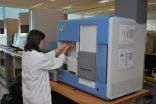(Press-News.org) New research by Rice University scientists suggests that a class of material known as metallacarborane could store hydrogen at or better than benchmarks set by the United States Department of Energy (DOE) Hydrogen Program for 2015.
The work could receive wide attention as hydrogen comes into play as a fuel of the future for cars, in fuel cells and by industry.
The new study by Rice theoretical physicist Boris Yakobson and his colleagues, which appears in the online Journal of the American Chemical Society, taps the power of transition metals scandium and titanium to hold a load of hydrogen molecules -- but not so tightly that they can't be extracted.
A matrix made of metallacarboranes would theoretically hold up to 8.8 percent of its weight in hydrogen atoms, which would at least meet and perhaps surpass DOE milestones issued a year ago for cars that would run on hydrogen fuel.
Yakobson, a professor in mechanical engineering and materials science and of chemistry at Rice, said inspiration for the new study came from the development of metallacarboranes, now well-known molecules that combine boron, carbon and metal atoms in a cage-like structure.
"A single metal atom can bind multiple hydrogen molecules," Yakobson said, "but metals also tend to aggregate. Without something to hold them, they clump into a blob and are useless."
Abhishek Singh, lead author of the study, a former postdoctoral researcher for Yakobson and now an assistant professor at the Indian Institute of Science in Bangalore, India, calculated that boron clusters would grip the titanium and scandium, which would in turn bind hydrogen. "The metals fit like a gem in a setting, so they don't aggregate," Yakobson said. Carbon would link the clusters to form a matrix called a metal organic framework (MOF), which would act like a sponge for hydrogen.
Investigation of various transition metals showed scandium and titanium to have the highest rate of adsorption (the adhesion of transient molecules -- like hydrogen -- to a surface). Both demonstrate an affinity for "Kubas" interaction, a trading of electrons that can bind atoms to one another in certain circumstances. "Kubas is a special interaction that you often see mentioned in hydrogen research, because it gives exactly the right binding strength," Yakobson said.
"If you remember basic chemistry, you know that covalent bonds are very strong. You can bind hydrogen, but you cannot take it out," he said. "And on the other extreme is weak physisorption. The molecules don't form chemical bonds. They're just exhibiting a weak attraction through the van der Waals force.
"Kubas interaction is in the middle and gives the right kind of binding so hydrogen can be stored and, if you change conditions -- heat it up a little or reduce pressure -- it can be taken out. You want the framework to be like a fuel tank."
Kubas allows for reversible storage of hydrogen in ambient conditions -- ranging from well above to well below room temperature -- and that would make metallacarborane materials highly attractive for everyday use, Yakobson said. Physisorption of hydrogen by the carbon matrix, already demonstrated, would also occur at a much lower percentage, which would be a bit of a bonus, he said.
Other studies have demonstrated how to make carborane-based MOFs. "That means they can already make three-dimensional frameworks of material that are still accessible to gas. This is very encouraging to us," Yakobson said. "There are many papers where people analyze a cluster and say, 'Oh, this will also absorb a hydrogen,' but that's not useful. One cluster is nothing.
"But if chemists can synthesize this particular framework with metallacarborane as an element, this may become a reality."
INFORMATION:
Arta Sadrzadeh, a graduate student in Yakobson's lab, is a co-author.
Read the abstract here: http://pubs.acs.org/doi/abs/10.1021/ja104544s
Artwork is available here:
http://www.media.rice.edu/images/media/NEWSRELS/PR-3.jpg
Hydrogen fuel for thought
Rice researchers find metallacarboranes may meet DOE storage goals
2010-10-01
ELSE PRESS RELEASES FROM THIS DATE:
URI professor warns: TV viewing likely to make you fear sickness
2010-10-01
KINGSTON, R.I.-– September 30, 2010 –Watching television and its heavy dose of medical content in news and drama can lead to more concern about personal health and reduce a person's satisfaction with life according to a new study out of the University of Rhode Island.
The study, authored by Yinjiao Ye, assistant professor of communications studies found that TV viewing affects people's awareness of health-risks and whether they believe they can protect their own health. People develop these perceptions because TV viewing leads them to believe they have a greater likelihood ...
Tea leaves identified using neural networks
2010-10-01
A team of chemists from the University of Seville (US) has managed to distinguish between different kinds of tea leaves on the basis of their mineral content and by using artificial neural networks. This technique makes it possible to differentiate between the five main varieties of tea – white, green black, Oolong and red tea.
"This method makes it possible to clearly differentiate between the five types of tea – something that is often not easy to do by eye alone – by using analysis of the leaves' mineral content and then mathematically processing these data", José ...
Catalyst sandwich
2010-10-01
Northwestern University researchers have taken another step towards realizing a new class of polymerase chain reaction (PCR) enzyme mimics, opening the door for the development of highly sensitive chemical detection systems that go beyond nucleic acid targets.
The blueprint for building synthetic structures to detect and signal the presence of targets such as small molecule medical analytes (signalers of disease or bodily malfunction, such as neurotransmitters) and environmental hazards, such as TNT, to name just a few, is inspired by biology and its allosteric enzymes. ...
Testing African couples for HIV is cost-effective prevention strategy
2010-10-01
As researchers and policymakers work toward an effective HIV vaccine in a constrained global economy, cost-effective prevention strategies such as Couples Voluntary Counseling and Testing (CVCT) must take a larger role in efforts to decrease the rates of HIV/AIDS in Africa, says Emory University HIV/AIDS vaccine researcher Susan Allen, MD, MPH.
Allen, who has worked to combat the AIDS epidemic in Africa for more than 25 years, highlighted the value of CVCT and other cost-effective HIV prevention strategies today at the AIDS Vaccine 2010 Conference in Atlanta.
"The ...
Chromosomal break gives scientists a break in finding new puberty gene
2010-10-01
A break in the two chromosomes has given scientists a break in finding a new gene involved in puberty, Medical College of Georgia researchers report.
It's also helped clear up why some patients with delayed puberty have no sense of smell, said Dr. Lawrence C. Layman, chief of the MCG Section of Reproductive Endocrinology, Infertility and Genetics.
The WRD11 gene interacts with a transcription factor that appears to be involved in development of gonadotropin releasing hormones that enable sexual maturation as well as olfactory neurons in the brain, according to a study ...
Bedouin tribe reveals secrets to McGill's GA-JOE
2010-10-01
Van Den Ende-Gupta syndrome (VDEGS) is an extremely rare genetic disorder that is characterized by distinctive head and facial features, such as unusual eyelids, narrow and beaked noses, flat nasal bridges, jaw deformities, and a turned out lower lip. As part of McGill's "RaDiCAL" project (Rare Disease Consortium for Autosomal Loci), collaborators in Qatar conducted field research with three patients from biologically interrelated Bedouin families, and sent samples to Canada for analysis by GA JOE – a high-tech genome analyzing machine. The research effort was led by husband ...
Key leukemia defense mechanism discovered by VCU Massey Cancer Center
2010-10-01
Richmond, Va. (September 30, 2010) – Virginia Commonwealth University Massey Cancer Center researcher Steven Grant, M.D., and a team of VCU Massey researchers have uncovered the mechanism by which leukemia cells trigger a protective response when exposed to a class of cancer-killing agents known as histone deacetylase inhibitors (HDACIs). The findings, published in the Journal of Biological Chemistry, could lead to more effective treatments in patients with leukemia and other cancers of the blood.
"Our findings provide new insights into the ways such cancer cells develop ...
'Great strides' in treatment of stroke, headache, epilepsy
2010-10-01
MAYWOOD, Il. -- The latest advances in treating neurologic disorders such as stroke, headache, Parkinson's disease, epilepsy and sleep disorders are detailed in a special issue of the journal Neurologic Clinics.
Guest editor is Dr. Jose Biller, chairman of the Department of Neurology at Loyola University Chicago Stritch School of Medicine.
"Great therapeutic strides in the clinical neurosciences have been made in the past decades," Biller wrote in the preface to the November 2010 issue, now available online. "It is likely that subsequent decades will bring even greater ...
OHSU Toxicology Research Center issues public alert on popular hair salon treatment
2010-10-01
PORTLAND, Ore. — Oregon Health & Science University's Center for Research on Occupational and Environmental Toxicology (CROET) is responding to concerns raised by Portland-area hair salons about a product used for hair straightening. CROET has issued two public alerts describing its findings on the possible negative health impacts of this product.
The product being tested is called Brazilian Blowout. After receiving two samples from Portland-area salons, CROET asked the Department of Consumer and Business Services' Oregon Occupational Safety & Health Division to chemically ...
October 2010 Geology and GSA Today highlights
2010-10-01
Boulder, CO, USA – The October Geology includes a study using fish teeth to understand ocean circulation; discussion of the "Dead Clade Walking" taxa; description of the first reported example of igneous aragonite; discovery of a Paleogene California River, flowing in similar location but opposite direction to the Colorado River; a report of the earliest definite record of predation on pelagic sea lilies; and discovery of the only known active drumlin field in the world. GSA Today examines calderas.
Relationship between mass extinction and iridium across the Cretaceous-Paleogene ...
LAST 30 PRESS RELEASES:
Injectable breast ‘implant’ offers alternative to traditional surgeries
Neuroscientists devise formulas to measure multilingualism
New prostate cancer trial seeks to reduce toxicity without sacrificing efficacy
Geometry shapes life
A CRISPR screen reveals many previously unrecognized genes required for brain development and a new neurodevelopmental disorder
Hot flush treatment has anti-breast cancer activity, study finds
Securing AI systems against growing cybersecurity threats
Longest observation of an active solar region
Why nail-biting, procrastination and other self-sabotaging behaviors are rooted in survival instincts
Regional variations in mechanical properties of porcine leptomeninges
Artificial empathy in therapy and healthcare: advancements in interpersonal interaction technologies
Why some brains switch gears more efficiently than others
UVA’s Jundong Li wins ICDM’S 2025 Tao Li Award for data mining, machine learning
UVA’s low-power, high-performance computer power player Mircea Stan earns National Academy of Inventors fellowship
Not playing by the rules: USU researcher explores filamentous algae dynamics in rivers
Do our body clocks influence our risk of dementia?
Anthropologists offer new evidence of bipedalism in long-debated fossil discovery
Safer receipt paper from wood
Dosage-sensitive genes suggest no whole-genome duplications in ancestral angiosperm
First ancient human herpesvirus genomes document their deep history with humans
Why Some Bacteria Survive Antibiotics and How to Stop Them - New study reveals that bacteria can survive antibiotic treatment through two fundamentally different “shutdown modes”
UCLA study links scar healing to dangerous placenta condition
CHANGE-seq-BE finds off-target changes in the genome from base editors
The Journal of Nuclear Medicine Ahead-of-Print Tip Sheet: January 2, 2026
Delayed or absent first dose of measles, mumps, and rubella vaccination
Trends in US preterm birth rates by household income and race and ethnicity
Study identifies potential biomarker linked to progression and brain inflammation in multiple sclerosis
Many mothers in Norway do not show up for postnatal check-ups
Researchers want to find out why quick clay is so unstable
Superradiant spins show teamwork at the quantum scale
[Press-News.org] Hydrogen fuel for thoughtRice researchers find metallacarboranes may meet DOE storage goals


